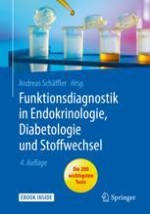Zusammenfassung
Erläutert werden alle relevanten Funktionstests mit ausführlicher Darstellung von Indikationen, Kontraindikationen, Nebenwirkungen, Testvorbereitung, Rahmenbedingungen, konkreten Handlungsanleitung der eigentlichen Testdurchführung sowie der Interpretation der Testergebnisse. Es werden immer konkrete Normbereiche und Cut-off-Werte angegeben, auch für besondere Situationen (Geschlecht, Alter, BMI, Pubertätsphasen, Zyklusphasen, akute Erkrankungen, Medikamente etc.). Ein besonderes Merkmal ist die Betonung der Testvorbereitung, -durchführung und -interpretation sowie des interdisziplinären Charakters. Gastrointestinale Hormone und Peptide wie Gastrin, Serotonin, VIP, Glukagon, Somatostatin oder PP sind entscheidend bei neuroendokrinen Tumoren, Karzinoiden bzw. GEP-NET-Tumoren. Neben basalen Werten spielt der Sekretintest eine wichtige Rolle. Der intra-arterielle Calciumstimulationstest bei der Insulinom-Diagnostik wird erläutert.











